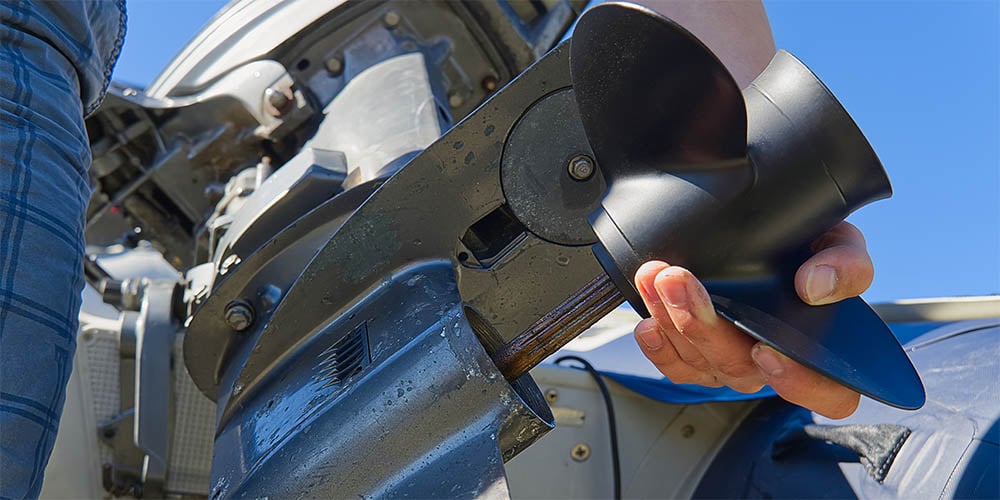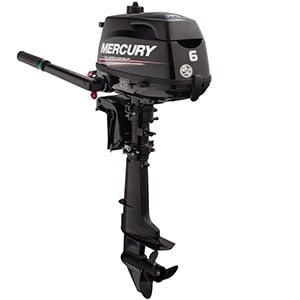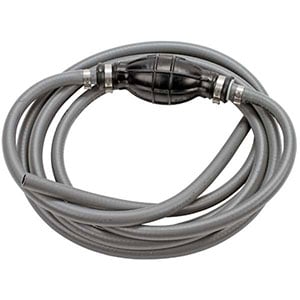
It’s easy to keep your outboard in top shape, even if you’re not a mechanic. A little TLC and preventive maintenance can keep your motor running reliably for years to come. Follow the manufacturer’s recommendations where they differ from our advice, and consider these quick tips.
Before Every Trip
- Check that you have adequate clean fuel and that the fuel tank vent is open
- Make sure the oil tank (if the engine has one) is topped up
- If the engine is not thru-bolted to the transom, ensure that the engine mount screw clamps are secure and tight
- Check that the water intake pickup is clean and free from debris
- Check your prop for fishing line wrapped around the hub area, and check for excess oil buildup near the prop (a small amount is normal, so look for changes in the quantity) indicating a deterioration of the lower unit seal

Modern 4-stroke outboards are tremendously cleaner and quieter than 2-strokes, and consume about 40 percent less fuel.
After Every Trip
- After every outing, flush out the engine. This doesn’t just apply to salt water adventures, but to fresh water outings as well, if there has been sand, gravel, pollution or other debris in the water.
- Buy a set of “ear muffs,” an engine flusher with two flexible rubber seals connected with a metal clamp. Slip the apparatus onto the lower unit where the water is picked up and attach a garden hose. Open the tap no more than about one-quarter of maximum water pressure (full water pressure from a city water system could damage the internal seals in your outboard motor).
- Start up the engine, run it up to about 2,000rpm (or to your engine manufacturer’s recommended rpm setting) and let the water pump do the rest. Allow the motor to run up to operating temperature, so the thermostat will open and allow water to circulate through the cooling system. (Stay clear of the prop and make sure no one tries to shift the motor into gear. Note: Many experts advise you to remove the prop for safety whenever running your engine out of the water)
- While you’re flushing the motor, check the water pump to make sure it has good water flow. Carefully put your finger through the stream of water. It may be warm, but it shouldn’t be hot. If the output is not strong, you may have some debris stuck in the outflow tube. Immediately shut down the engine to prevent overheating and damage.
- Insert a small piece of wire into the flow tube and work it back and forth. Start the engine again and check the output. If that doesn't solve the problem, you may need a new water pump.
- After flushing the engine, disconnect the fuel line and allow the engine to burn all the fuel in the carburetor.
- Once you’ve finished the flushing and run the engine out of fuel, turn off the key and the battery switch. This flushing procedure should take a total of about five to ten minutes.
- Wipe everything down and spray with a corrosion inhibitor. Lubricate all the moving parts such as the shift and throttle cables, carburetor linkages, etc.
- Lubricate moving parts, such as the shift and throttle cables and the carburator linkages.
- Replace the cowling and wipe it down. Keep a canvas or plastic cover on the engine between trips.
Routine Maintenance

Changing out cracked fuel lines for new EPA compliant low permeation lines is better for the environment, safer and saves fuel.
- Periodically check the fuel line for cracks and worn spots.
- Make sure the primer bulb is not cracked and is pliable.
- Make sure the fuel line fittings seat properly and don’t leak.
- Check the clamps on the fuel line for rust or corrosion.
- Check the fuel tank(s) for damage and corrosion.
- Check the tank vent to make sure it is free of obstructions.
- Check regularly for water in the fuel (especially important with fuels containing ethanol alcohol). If the engine has a clear fuel strainer, check if any water has collected there. It will be a relatively clear layer at the bottom of the strainer.
- Lubricate the engine tilt and steering grease points every 100 hours or annually (whichever is less).
- Check for engine corrosion, and replace the sacrificial anodes if they are corroded more than 50 percent.
- Clean the exterior with boat soap and apply a good wax job.
- Inspect the propeller for dents and dings.
- Change the engine oil and replace the oil filter
- Replace the water pump impeller every 300 hours of use, or every three years (more often if you use the engine in conditions where sand is drawn through the cooling system).
- Take your engine to a dealer for an annual service. Depending on your engine type, you’ll get new spark plugs, new oil and oil filter, a new gas filter, a valve adjustment, and a new water pump impeller.
Boat Engine and Repair Manuals
- SELOC Boat engine owner's manuals and repair manuals for specific brands, models and ages of outboards